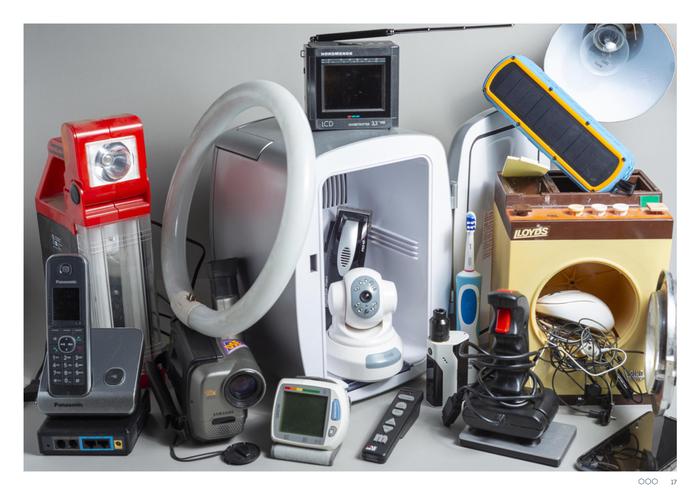We have reached 53.6 million electronic garbage produced only last year in the world, equivalent to 350 ocean liners lined up. In five years the mass of objects made with circuits, electronic parts, with or without batteries, has increased by 21% and is destined to increase further because we are dependent on electronics. We Italians have between 15 and 20 kilos of electronic waste each , a real record, and it is urgent to remedy it.
The signatories of the new report 'Global e-waste monitor 2020' by the United Nations University, member of the United Nations General Assembly, sound the alarm . The only solution - say the authors - lies in adopting the principles of the circular economy ranging from proper disposal to recycling of electronic parts to repairs of used items.
Air conditioners, televisions, monitors of all sizes, light bulbs, household appliances, printers, fans, electric and electronic toys, cell phones, transformers, batteries. Plus 'smart' clothes and devices. How many are there in offices and public places? How many do you have at home? And in your children's room? How many electronic toys do your children play with, maybe putting them in their mouths even when broken? How many do you throw away each year and how many do you get repaired? These are objects that pollute the environment, are toxic to our health and instead end up in landfills while they could even be worth a treasure if recycled correctly by everyone, institutions, municipalities and individual citizens. Electronic waste contains a long list of precious metals and those produced last year would be worth $ 57 billion because they contain gold, platinum, silver, copper and so on. Instead they ended up in incinerators and landfills, when not scattered around. How can we stop this trend? The circular economy involves disposal through a precise chain organized between municipalities and private companies that allows the recovery of the 'pieces' and their regeneration. A mountain of second-hand pieces that could be reused and instead thrown away. If on average in the world every man, woman or child generates 7.3 kg of garbage of this type, Europeans have 16.2 kilos each. The Italians do even worse: among the countries of southern Europe we are at the bottom of the list and we have 15 to 20 kilos per capita of electronic waste.
“If this trend is not slowed down, electronic products ending up in landfills will become 74 tons by 2030 and will double in the next sixteen years. We are increasingly dependent on these objects which also have a shorter life cycle and less chance of being repaired ", the authors specify. "These are wastes that have a high risk for the environment and for health due to the release of CO2 and the content of toxic compounds such as mercury which can damage the human brain and nervous system." And not these are traces: at least 50 tons of mercury are estimated annually from old monitors, circuits and energy-saving fluorescent bulbs .
"The results of this year's report indicate that humanity is not implementing recycling systems sufficiently. Greater efforts are urgently needed to ensure smarter and more sustainable global production, consumption and disposal of electrical and electronic equipment. There is an urgent need to reverse this dangerous model followed globally, "says David M. Malone, rector of United Nations University and under-secretary general of the United Nations.
How to recover this kind of waste? The authors explain that the collection activities today are not enough and even where we start with the collection through retailers, municipal collection points and home collection services for separate collection it is not said that the electronic 'bits' do not end up in the incinerators or in landfills instead of being recovered. Not to mention what happens in developing countries where millions of people collect and recycle electronic waste in the first person and then sell it to those who repair, renovate or dismantle it in their 'courtyard', causing serious damage to the environment and human health .
Everyone can do their part by learning to separate the electronic parts from the rest, where possible, by going to the public collection points for formal disposal or using the 'door to door' following the directions of your town hall, also by reporting any disservices. UN experts also recommended not to let children play with broken and poorly preserved electronic toys that they often put in their mouths and to pay attention to 'do it yourself' repairs at home even if there are passionate teenagers or 'geeks'. Circuits and small electronic pieces scatter traces in the environment and are dangerous.
The circular economy also applies in the 'small', locally and in individual neighborhoods. After years of unbridled 'electronic' consumerism, in fact, there is a thriving increase in shops for the repair of electronic objects in cities across the peninsula. The slowdown in consumption recorded in the black months by Covid-19 is making us rethink our habits and the assistance and repair centers for household appliances and electronic objects have an increasingly long waiting list. In full Chinatown in Milan, 'Johnny the fixer' (and his brothers) is the undisputed king for repairs of all kinds of electronic trinkets (in via Giordano Bruno). In Rome the clinics for the repair of mobile phones and talbets sprout like mushrooms and each neighborhood has shops (even booths without sign but renowned for word of mouth) where young and very experienced boys, often Indians, repair every type of electronic object, collecting bits of scrap useful for regenerating other objects. Even on the front of the appliances, dealers are increasingly doing business, which also offer on-site assistance, not to mention that the market for 'regenerated' electronic objects, also guaranteed by the same brands that produce new ones, is increasingly flourishing.

